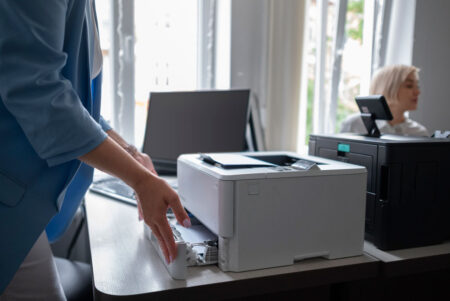Find out how the lowly photocopier transformed the way we work.
- Copiers have drastically changed since they were first introduced in 1938 in a much less sophisticated form.
- Xerox transformed the way photocopiers were used, which changed the working world for the better.
- Digital copiers are preferred because they are easier to maintain and more efficient, help boost productivity, foster seamless collaborations, and allow users to make professional-quality prints without paying for print shop services.
By now, you’ve likely read about the incredible potential brought on by 3D printing technology. As the ability to create objects from a mere blueprint becomes increasingly common, we can gain perspective on how far we’ve come from by looking back at where it all began: the photocopier.
Inventor Chester Carlson
On Oct. 22, 1938, inventor Chester Carlson first harnessed static electricity by using a handkerchief, light and dry powder to create a copy. His first experiments were literally explosive: He caused many sulfur fires, nearly burning down his apartment.
The inventor later developed spinal arthritis. He kept up his experiments for most of his life while studying law and keeping a regular job. He did patent his experiments, though. In December 1946, he signed the first agreement to license electrophotography for commercial use. It would be years before people could actually use this technology as they do now. Until then, secretaries everywhere were stuck using carbon paper to make copies.
Editor’s note: Need a photocopier for your business? Fill out the below questionnaire to have our vendor partners contact you with free information.
Xerox, a pioneer in photocopying technology
The photocopier was the transformative office tool of its time. Imagine tackling your work without it – painstakingly copying every document by hand. There were numerous attempts at early copy automation, yet all were imperfect.
In 1959, Xerox released the first “modern” version of the photocopier. It was called 914, and it was bulky, heavy and hard to use. It was about the size of two washing machines, and some of these copiers literally caught on fire.
The machine used a rotating drum to create an electrostatic copy image. The image was transferred to fresh paper using toner, and then the whole thing was sealed using heat. It could create copies in just seven seconds – not far off from the printing speeds of copying and printing machines you might purchase today. This was just the beginning of the wonder of photocopying technology, which rapidly hit offices across the country.
A forever-changed workplace
The fast popularity of photocopiers took even Xerox by surprise. The company had estimated that a typical customer would make approximately 2,000 copies a month. But many customers made 10,000 copies; some made 100,000 copies. The technology had taken off.
Beyond making copies easy to obtain, the photocopier changed workplace culture and workflows. Prior to the invention, a single hard copy of a document would slowly make its way around the office. Tracking who viewed it (or approved it) was a completely manual process. The photocopier, in many ways, was the earliest tip of the sharing and collaboration boom. Knowledge – such as magazine articles, letters and news clips – could be easily copied and shared. Why? It was more like, “Why not?” The photocopier was there, simply waiting to be used. [Interested in a copy machine? Check out our best picks.]
Competitors join the market
It wasn’t until the 1970s that other technology companies joined the fun. Companies such as Canon and Minolta released their own photocopiers – yet Xerox continued to dominate the market. Over time, these competing technologies improved, and consumers eventually had access to a wide range of photocopiers, from low-end units to enterprise models.
Despite the advent of scanners and document digitization, the use of paper perseveres. In fact, one study reports that “73% of the ‘owners and decision-makers’ at companies with fewer than 500 employees print at least four times per day.”
Today’s copiers
Copiers are now more multifunctional devices, often known as all-in-ones. They copy, print, fax and scan from one place. Many modern photocopiers can track usage to reduce unnecessary printing and copying. The most advanced machines have digital touchscreen displays, wireless accessibility and other user-friendly features.
The machines range wildly in price, and many printer companies offer numerous configuration options, allowing businesses to customize their machines. Businesses that don’t have the cash on hand to buy a machine might lease one instead.
According to All Copy Products, digital printers are much easier to maintain than the previous versions. Much of the testing and other tasks that help to maintain premium quality and functionality can be completed with the click of a button. Troubleshooting can be handled digitally also, so there is often no need to contact the company or hire costly repairmen.
These printers also provide much higher-quality copies. In fact, many digital printers were created to match or even surpass the quality of prints you would receive from a print shop. This is excellent for businesses that frequently print photos, as it is possible to shoot and print your own professional-level portraits without outside help from professionals.
Digital copiers are typically much more efficient than previous versions. The software that comes along with digital printers ensures that the printers are faster, and they offer new and exciting features that can promote seamless collaboration and boost productivity in the workplace. Additionally, they are easier to use in general, making them preferred by businesses of all sizes.


